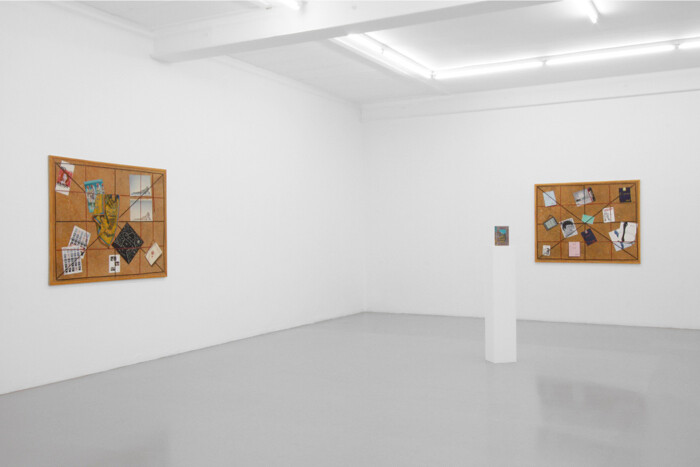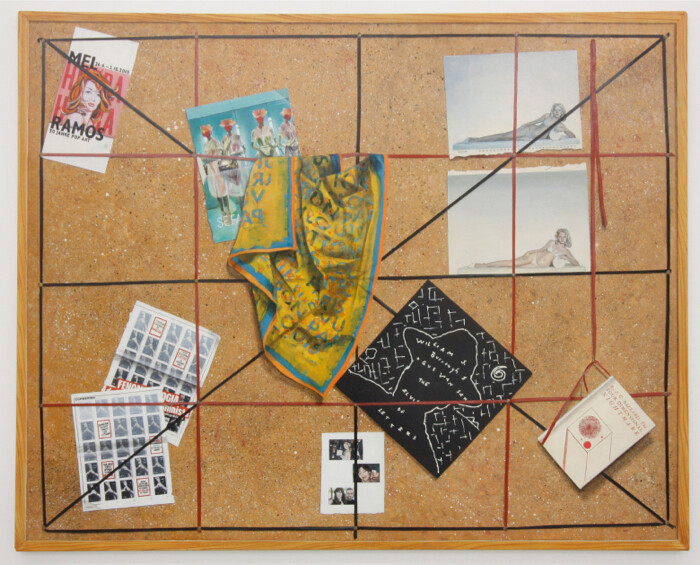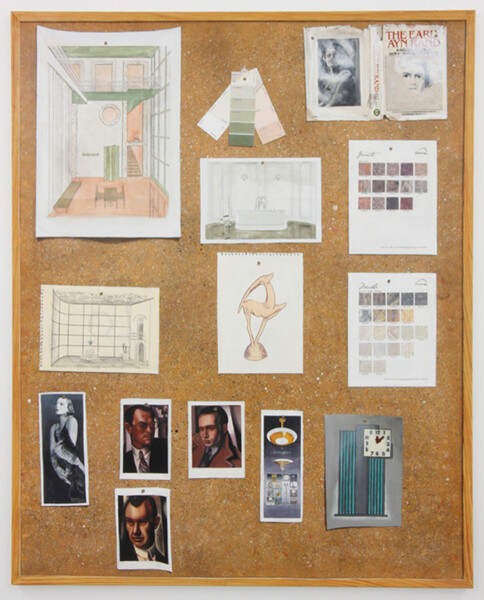In a recent conversation with the Scottish artist Lucy McKenzie published in Mousse magazine, the French-British artist Marc Camille Chaimowicz described McKenzie’s work as having “conscious slippage.” It sounded a bit cryptic, but after having visited her recent exhibition of paintings at the Antwerp gallery Micheline Szwajcer, I knew exactly what he meant. First of all, nothing in the exhibition is what it appears to be; the bulletin boards holding collages of items are in fact paintings, and the faux-Agatha Christie novel displayed on a pedestal literally covers up the recent chick-lit hit and title-giving novel Fifty Shades of Grey by E.L. James. Both paintings and book cover are trompe l’oeil: an intended slippage between reality and illusion.
Most of the works in this exhibition consist of recent additions to the series of paintings titled “Quodlibet,” a Latin term which, amongst other things, means “that which pleases”. McKenzie uses it here to refer to a genre within trompe l’oeil painting en vogue in architecture in the early 19th century which featured realistically rendered wall paintings of random items (playing-cards, ribbons, and scissors). Different from the Baroque use of architectural trompe l’oeil, which created the illusion of an expanded space—or in its clerical form to “open up” the space to heaven—the quodlibet’s primary purpose was to intellectually entertain. The question then is what intellectual riddles has McKenzie invited us to decipher?
In the first room of the gallery, the bulletin board painting Quodlibet XXIII (all works 2012) depicts cut-outs from a magazine, a record cover of Gus Van Sant’s memorable musical adaptation of William S. Burroughs’s Beat writings, The Elvis of Letters, a silk scarf, and a paperback copy of J.G. Ballard’s The Four-Dimensional Nightmare. But what catches the eye is the image of a bikini-clad girl, portrayed as an iconic reclining nude, with an almost perfect copy of the image placed below it, which differs only slightly in shade.
The assemblage of cultural references and emblems of popular culture here hint towards a certain theme but remain quite ambiguous at the same time. Given McKenzie’s feminist inclinations, it is safe to presume that what we are seeing is a loose form of commentary on the misogynist quirks of dominant male culture, bearing in mind, of course, the legacy of feminist artists like Martha Rosler, Adrian Piper, Louise Lawler, and Sherrie Levine, who employed strategies of appropriation to critically question dominant narratives in art-history or culture at large.
However, this is not the whole story. Just as the relation between the copy and its original is marred by a slight nuance in color, a subtle slippage, if you will, McKenzie’s adoption (or appropriation) of the feminist style is not one-to-one either.
In addition to an interest in the Arts and Crafts movement, like Chaimowicz, McKenzie evinces her fascination with interiors. (McKenzie: “You can read a person’s character by his or her interior.”) In the second room of the gallery, one finds a triptych of collages or “mood boards” with design proposals for a bathroom. These paintings—Quodlibet, XII, XXII and XX—have been subtitled Objectivism, Nazism, Fascism, respectively. Assembling copies of industrial paint samples, different types of marble, architectural drawings, pictures of furniture, one can also find references to disparate symbols such as Ayn Rand, Tamara de Lempicka or a pamphlet titled “Das Behagliche Heim,” describing “how one recognizes a National Socialist by his home.”
The motive of the bathroom stems from Greil Marcus’s book on post punk, titled In the Fascist Bathroom, which inspired McKenzie to literally explore what this bathroom might look like (also here on view as a maquette). But beyond envisioning its formal and stylistic appearance, the paintings also raise questions about the ideological and political dynamics at play in the act of appropriation: each painting represents the slightly different adaptation of one aesthetic style into its own ideological narrative. Although McKenzie’s apparently neutral approach to the subject matter seems to suggest that appropriation is simply a technique, every form of appropriation, be it technical, stylistic or conceptual, harbors a moment of subjective interpretation and is, as such, political.
It is in this grey area where the underlying theme of the exhibition is located. Indirectly, “50 Shades” addresses the question of how an artist deals with the processing and transformation of source materials. How much distance or ambiguity does one allow for when recontextualizing these found materials into a new work?
Indeed, McKenzie’s paintings do generate moments of “conscious slippage” when dissonant, juxtaposed elements open up a whole array of associations and possible interpretations. However, I am not convinced that her paintings hold the critical weight necessary to deconstruct ideologically top-heavy subjects such as the male gaze or the intermingling of style and politics, such as earlier feminist artists set out to do. But then again, maybe that’s not her story either.





